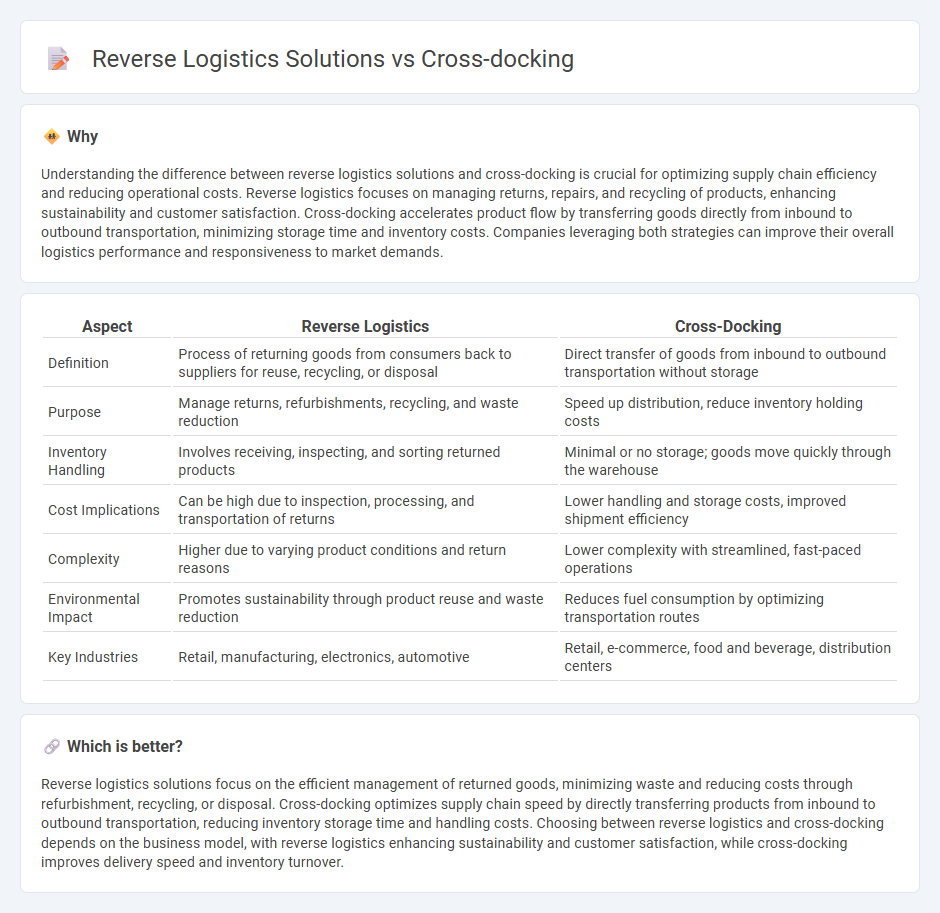
Reverse logistics solutions focus on managing product returns, recycling, and refurbishing to enhance sustainability and reduce waste. Cross-docking streamlines distribution by transferring goods directly from inbound to outbound transportation, minimizing storage time and lowering handling costs. Explore more to understand which logistics strategy aligns best with your supply chain goals.
Why it is important
Understanding the difference between reverse logistics solutions and cross-docking is crucial for optimizing supply chain efficiency and reducing operational costs. Reverse logistics focuses on managing returns, repairs, and recycling of products, enhancing sustainability and customer satisfaction. Cross-docking accelerates product flow by transferring goods directly from inbound to outbound transportation, minimizing storage time and inventory costs. Companies leveraging both strategies can improve their overall logistics performance and responsiveness to market demands.
Comparison Table
| Aspect | Reverse Logistics | Cross-Docking |
|---|---|---|
| Definition | Process of returning goods from consumers back to suppliers for reuse, recycling, or disposal | Direct transfer of goods from inbound to outbound transportation without storage |
| Purpose | Manage returns, refurbishments, recycling, and waste reduction | Speed up distribution, reduce inventory holding costs |
| Inventory Handling | Involves receiving, inspecting, and sorting returned products | Minimal or no storage; goods move quickly through the warehouse |
| Cost Implications | Can be high due to inspection, processing, and transportation of returns | Lower handling and storage costs, improved shipment efficiency |
| Complexity | Higher due to varying product conditions and return reasons | Lower complexity with streamlined, fast-paced operations |
| Environmental Impact | Promotes sustainability through product reuse and waste reduction | Reduces fuel consumption by optimizing transportation routes |
| Key Industries | Retail, manufacturing, electronics, automotive | Retail, e-commerce, food and beverage, distribution centers |
Which is better?
Reverse logistics solutions focus on the efficient management of returned goods, minimizing waste and reducing costs through refurbishment, recycling, or disposal. Cross-docking optimizes supply chain speed by directly transferring products from inbound to outbound transportation, reducing inventory storage time and handling costs. Choosing between reverse logistics and cross-docking depends on the business model, with reverse logistics enhancing sustainability and customer satisfaction, while cross-docking improves delivery speed and inventory turnover.
Connection
Reverse logistics solutions streamline the process of returning goods from consumers to manufacturers, minimizing waste and reducing costs. Cross-docking facilitates efficient sorting and redistribution of returned products by directly transferring them between inbound and outbound transportation without long-term storage. Integrating reverse logistics with cross-docking enhances supply chain agility, accelerates inventory turnover, and improves overall operational efficiency.
Key Terms
Transfer Point
Cross-docking optimizes supply chain efficiency by directly transferring goods from inbound to outbound transportation with minimal storage, reducing inventory costs and delivery times at the transfer point. Reverse logistics solutions manage the return flow of products from customers back to warehouses or manufacturers, emphasizing inspection, refurbishing, or disposal processes at the transfer point. Explore how integrating cross-docking and reverse logistics transfer points can enhance your operational agility and cost management.
Returns Management
Cross-docking accelerates the flow of goods by directly transferring inbound shipments to outbound vehicles with minimal storage, optimizing speed and reducing inventory costs. Reverse logistics in returns management focuses on efficiently handling returned products, including inspection, refurbishment, and disposition, enhancing customer satisfaction and minimizing losses. Explore our detailed insights on how integrating cross-docking and reverse logistics solutions can streamline your returns management process.
Inventory Flow
Cross-docking optimizes inventory flow by minimizing storage time, where products are directly transferred from incoming to outgoing shipments, reducing handling and lead times. Reverse logistics focuses on the efficient management of returned, defective, or excess goods, ensuring seamless movement back into inventory or disposal channels while maintaining accurate tracking and quality control. Explore in-depth strategies to enhance inventory flow through integrated cross-docking and reverse logistics solutions.
Source and External Links
Cross Docking: Definition, History, and Process - Inbound Logistics - Cross docking is a shipping method that transfers goods directly from incoming to outgoing transportation with minimal to no storage, using methods such as continuous cross docking, consolidation, and de-consolidation to improve efficiency and reduce handling and transportation costs.
What Is Cross-Docking? Definition, Types & Advantages - NetSuite - Cross-docking is a supply chain strategy where goods are unloaded from inbound vehicles and directly transferred to outbound vehicles, minimizing warehouse storage, speeding up delivery, and reducing costs for businesses.
Understanding cross-docking: A comprehensive guide - Maersk - Cross-docking is a logistics process allowing products to move from suppliers to customers with minimal storage, categorized by timing of distribution (pre- or post-distribution) and methods such as continuous, consolidation, and deconsolidation, with specialized applications in retail, manufacturing, and e-commerce.
 dowidth.com
dowidth.com